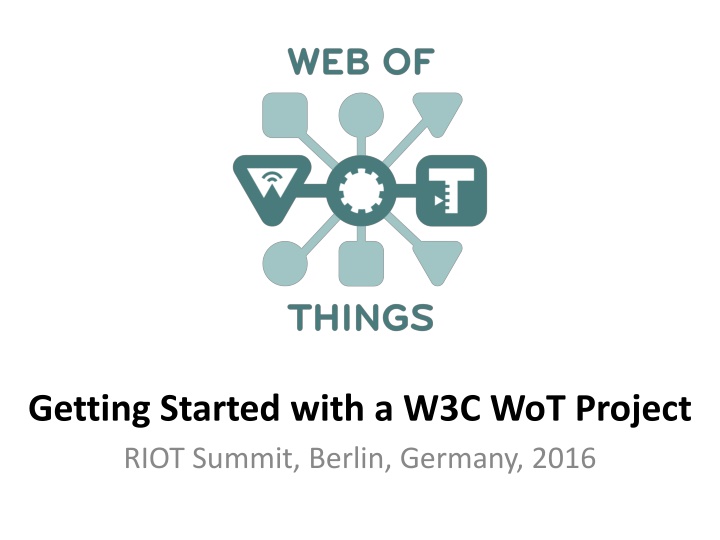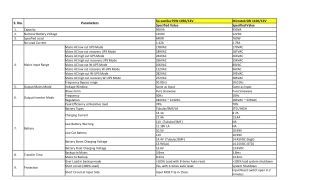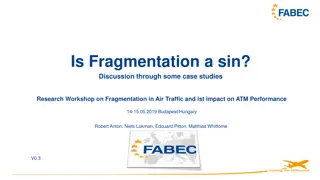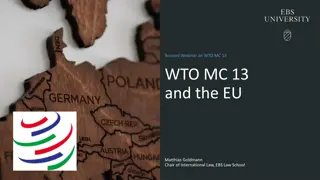
Exploring Web of Things: Connectivity and Protocols
Discover the intricacies of the Web of Things (WoT) project through images and descriptions showcasing connectivity options like LoRa, Ethernet, Wi-Fi, Bluetooth, IEEE 802.15.4, and diverse protocol bindings to interface servients with the network. Learn how WoT aims to enhance existing IoT platforms without being just another standard.
Download Presentation

Please find below an Image/Link to download the presentation.
The content on the website is provided AS IS for your information and personal use only. It may not be sold, licensed, or shared on other websites without obtaining consent from the author. If you encounter any issues during the download, it is possible that the publisher has removed the file from their server.
You are allowed to download the files provided on this website for personal or commercial use, subject to the condition that they are used lawfully. All files are the property of their respective owners.
The content on the website is provided AS IS for your information and personal use only. It may not be sold, licensed, or shared on other websites without obtaining consent from the author.
E N D
Presentation Transcript
Getting Started with a W3C WoT Project RIOT Summit, Berlin, Germany, 2016
What is the Web of Things? Application Layer Internet of Things : Connectivity LoRa Ethernet Wi-Fi Bluetooth IEEE 802.15.4
What is the Web of Things? Internet of Things : Connectivity LoRa Ethernet Wi-Fi Bluetooth IEEE 802.15.4
What is the Web of Things? Web of Things: Applications Internet of Things : Connectivity LoRa Ethernet Wi-Fi Bluetooth IEEE 802.15.4
W3C WoT Mission Not to be yet another standard Web of Things interconnecting existing Internet of Things platforms and complementing available standards
IoT Platforms and Protocol Bindings http://w3c.github.io/wot/current-practices/ wot-practices.html#wot-interface WoT INTERFACE
WoT Interface Interface exposed by Servients to the network WoT Servient WoT Servient WoT Interface WoT Interface
WoT Interface Interface exposed by Servients to the network WoT Servient WoT Servient WoT Interface WoT Interface Protocol
Protocol Bindings Interface can be bound to various protocols WoT Servient WoT Servient Protocol Bindings Protocol Bindings HTTP HTTP WoT Interface WoT Interface HTTP
Protocol Bindings Interface can be bound to various protocols WoT Servient WoT Servient Protocol Bindings Protocol Bindings CoAP CoAP WoT Interface WoT Interface CoAP
Protocol Bindings Multiple bindings possible on Things WoT Servient WoT Servient Protocol Bindings Protocol Bindings MQTT WS WS WoT Interface WoT Interface WebSocket
Resource Model Interaction points are Web resources WoT Servient WoT Servient Resource Model Resource Model Protocol Bindings Protocol Bindings WoT Interface WoT Interface
Servient Role Exposing Things are in server role Consuming Things are in client role WoT Servient WoT Servient Interaction Resources Web Links http://wot.example.com/res Protocol Bindings Protocol Bindings Client Role Server Role
Servient Role Usually both roles at the same time Servient WoT Servient WoT Servient WoT Servient Web Links Web Links Interaction Resources Interaction Resources Web Links Protocol Bindings Protocol Bindings Protocol Bindings Client Role Both Roles Both Roles
Metadata and Interactions http://w3c.github.io/wot/current-practices/ wot-practices.html#thing-description THING DESCRIPTION
How to Interact with WoT Servients? Who are you? What kind of data do you serve? WoT Servient Resource Model How can I access the data/function? Protocol Bindings What kind of functions do you have? WoT Interface What kind of protocols/encodings do you support? Are there some security constrains? W3C Thing Description
Semantic Description Reach interoperability through Linked Data vocabularies subject, predicate, object triples rooted in the RDF model W3C Thing Description describes WoT Interface to interact with Things extensible with domain-specific vocabulary different serializations possible
Thing Description (TD) Describes Thing metadata and interactions WoT Servient WoT Servient Resource Model Resource Model Protocol Bindings Protocol Bindings WoT Interface WoT Interface
Thing Description (TD) Consuming Things are in client role Exposed Things are in server role WoT Servient WoT Servient Protocol Bindings Protocol Bindings Client Role Server Role
Thing Description (TD) Exposed Things provide Thing Description WoT Servient WoT Servient Interaction Resources Thing Description Protocol Bindings Protocol Bindings CoAP HTTP Client Role Server Role
Thing Description (TD) Consuming Things learn WoT Interface from TD WoT Servient WoT Servient Metadata, Web Links Interaction Resources Thing Description Protocol Bindings Protocol Bindings HTTP CoAP HTTP Client Role Server Role
Thing Description (TD) Thing-to-thing communication WoT Servient WoT Servient Metadata, Web Links Interaction Resources Thing Description Protocol Bindings Protocol Bindings HTTP CoAP HTTP Client Role Server Role
Thing Description (TD) Default serialization is JSON-LD based on well established JSON format different implementations and tools available @context defines vocabularies See TD example
TD Example { "@context": [ "http://w3c.github.io/wot/w3c-wot-td-context.jsonld", { "actuator": "http://example.org/actuator#" } ], "@type": "Thing", "name": "MyLEDThing", "uris": [ "coap://myled.example.com:5683/", "http://mything.example.com:8080/myled/" ], "encodings": ["JSON", "EXI"], "security": { "cat": "token:jwt", "alg": "HS256", "as": "https://authority-issuing.example.org" }, "properties": [
"properties": [ { "@type": "actuator:onOffStatus", "name": "status", "valueType": { "type": "boolean" }, "writable": true, "hrefs": [ "pwr", "status" ] } ], "actions": [ { "@type": "actuator:fadeIn", "name": "fadeIn", "inputData": { "valueType": { "type": "integer" }, "actuator:unit": "actuator:ms" }, "hrefs": [ "in", "led/in" ] }, { "@type": "actuator:fadeOut", "name": "fadeOut", "inputData": { "valueType": { "type": "integer" }, "actuator:unit": "actuator:ms" }, "hrefs": [ "out", "led/out" ] } Property Interaction resources Action Action Events(work in progress)
Type System Default currently based on JSON Schema http://w3c.github.io/wot/current-practices/ wot-practices.html#type-system Best start with simple types boolean integer number string Other systems can be plugged in under valueType field
How to Create a TD? Manually copy, paste, and modify http://w3c.github.io/wot/current-practices/ wot-practices.html#td-examples or look into the TD repository http://vs0.inf.ethz.ch:8080 (development repository, sometimes offline) Generate from development framework TD serialization based on the interactions provided
Runtime Environment and Portable Apps http://w3c.github.io/wot/current-practices/ wot-practices.html#scripting-api SCRIPTING API
Without Scripting API Application logic often implemented natively WoT Servient Application Logic C / C++ / Java / Resource Model Protocol Bindings WoT Interface
Scripting API Common runtime enables portable apps WoT Servient App Script Runtime Environment Client API Disc. API Server API Resource Model Protocol Bindings WoT Interface
Scripting API Common runtime enables portable apps WoT Servient Vendor A WoT Servient Vendor B App Script Runtime Environment Runtime Environment Client API Client API Disc. API Server API Disc. API Server API Resource Model Resource Model Protocol Bindings Protocol Bindings WoT Interface WoT Interface
Scripting API Common runtime enables portable apps WoT Servient Vendor A WoT Servient Vendor B App Script Runtime Environment Runtime Environment Client API Client API Disc. API Server API Disc. API Server API Resource Model Resource Model Protocol Bindings Protocol Bindings WoT Interface WoT Interface
WoT Root Element (with Discovery) interface WoT { Promise<sequence<ConsumedThing>> discover(ThingFilter filter); Promise<ConsumedThing> consumeDescription(Object td); Promise<ConsumedThing> consumeDescriptionUri(DOMString uri); Promise<ExposedThing> createThing(DOMString name); Promise<ExposedThing> createFromDescription(Object td); Promise<ExposedThing> createFromDescriptionUri(DOMString uri); };
Client API: ConsumedThing interface ConsumedThing { readonly attribute DOMString name; Promise<any> getProperty(DOMString propertyName); Promise<any> setProperty(DOMString propertyName, any newValue); Promise<any> invokeAction(DOMString actionName, any parameter); ConsumedThing addListener(DOMString eventName, ThingEventListener listener); ConsumedThing removeListener(DOMString eventName, ThingEventListener listener); ConsumedThing removeAllListeners(DOMString eventName); Object getDescription(); };
Server API: ExposedThing interface ExposedThing { readonly attribute DOMString name; ExposedThing addProperty(DOMString name, object type); ExposedThing addAction(DOMString name, Object input, Object output); ExposedThing addEvent(DOMString name, Object output); Promise<any> getProperty(DOMString propertyName); Promise<any> setProperty(DOMString propertyName, any newValue); Promise<any> emitEvent(DOMString eventName, any payload); ExposedThing onUpdateProperty(DOMString n, PropertyChangeListener cb); ExposedThing onInvokeAction(DOMString actionName, ActionHandler cb); Object getDescription(); };
Script Example (Consume Thing) WoT.consumeDescriptionUri("http://servient.example.com/things/counter") .then(function(counter) { counter .invokeAction("increment", {}).then(function() { console.log("incremented"); counter .getProperty("count").then(function(count) { console.log("new count state is " + count); }); })._catch(console.error); }) ._catch(function(err) { console.error(err); });
Script Example (Expose Thing) WoT.newThing("counter") .then(function(thing) { thing .addProperty("count", {"type": "integer"}) .addAction("increment") .onInvokeAction("increment", function() { console.log("incrementing counter"); var value = thing.getProperty("count") + 1; thing.setProperty("count", value); return value; }); thing .setProperty("count", 0) });
W3C Web of Things SUMMARY
Thing Implementation: WoT Servient Application Logic: Can consume remote Things through the Client API, local hardware and connected legacy devices through a Physical API (t.b.d.), and expose Things through the Server API. To allow portable app scripts, the Servient must povide a runtime environment. WoT Servient App Script (Physic. API) Client API Server API Discovery API Runtime Environment Resource Model: Provides a common abstraction with uniform interface across the different protocols. Like the Web, it allows to identify and address interaction points through URIs. Thing Resource Model Description Legacy comm- unication Protocol Bindings Thing Description (TD): Declares WoT Interface for interaction and provides (semantic) metadata for the Thing. TD is used by WoT clients to instantiate local software object of the Thing. Client Role Server Role Proprietary interface WoT Interface Protocol Binding: Converts abstract interactions with Things to different protocols using the information from TD. Legacy device Web Client Web Server WoT Servient WoT Servient
WoT Servient on Thing Itself Native WoT Things host a Servient directly TD is provided by Thing or supporting host on the Web WoT Servient (Wot Device) Browser App Script Script Runtime Env. Runtime Environment Resource Model Thing Resource Model Description Protocol Bindings Protocol Bindings Client Role Server Role Client Role
WoT Servient on Integration Hub WoT Servients can run on hubs (e.g., smartphone, gateway) Multiple Servients can be instantiated through sandboxed apps Apps can act as agents/proxies for legacy devices Hub Platform WoT Servient App Script Browser App Script Runtime Env. Runtime Environment Resource Model Thing Resource Model Description Protocol Bindings Legacy comm. Protocol Bindings Client Role Server Role Client Role Legacy device
WoT Servient in the Cloud A cloud mirror (device shadow) enables scalable remote access Is synchronized with local Servient Can forward interactions and cache data Cloud Platform Hub Browser WoT Servient WoT Servient App Script App Script App Script Runtime Envi. Runtime Environment Runtime Environment Resource Model Thing Resource Model Description Thing Protocol Binding Resource Model Protocol Binding Description Legacy comm. Protocol Binding Client Role Server Role Client Role Server Role Client Role Legacy device Cloud Anywhere Local
Online Resources Interest Group https://www.w3.org/WoT/IG/ https://lists.w3.org/Archives/Public/public-wot-ig/ (subscribe to mailing list) Documents (for implementers) http://w3c.github.io/wot/architecture/wot-architecture.html http://w3c.github.io/wot/current-practices/wot-practices.html (living document) Beijing 2016 Release: http://w3c.github.io/wot/current-practices/wot-practices-beijing-2016.html GitHub (documents and proposals) https://github.com/w3c/wot Wiki (organizational information: WebConf calls, Face-to-Face meetings, ) https://www.w3.org/WoT/IG/wiki/Main_Page WoT Projects (implementing WoT Current Practices) https://github.com/thingweb/ https://github.com/mkovatsc/wot-demo-devices Please add yours!
W3C WoT F2F Beijing 2016 PLUGFEST
Scenario 1 Hello WoT Setup servient interaction based on TD WoT TD interpreter for human interaction /on /voteTooHot
Scenario 2 Full WoT WoT Servient providing script for voting WoT Client consumes script /on /voteTooHot TD Repository Search for Action @type= tooHot WoT Servient searchs a voting servient
Scenario 3 Mini Automation Consume brightness sensor to control curtain
Online Resources Current Practices (Beijing Release) http://w3c.github.io/wot/current-practices/wot-practices-beijing-2016.html Organization Wiki https://www.w3.org/WoT/IG/wiki/F2F_meeting,_July_2016,_China,_Beijing#PlugFest Test Cases https://github.com/w3c/wot/blob/master/plugfest/2016-beijing/plugfest-test-cases- beijing-2016.md Report Template https://github.com/w3c/wot/blob/master/plugfest/2016-beijing/TestCaseCoverage.xlsx (t.b.d.)







